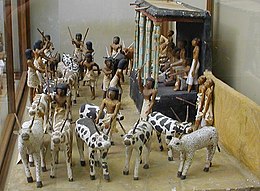Wooden tomb model
These types of jars would also go on to inspire wooden models of stone containers in the Middle Kingdom.
[7] During the Old Kingdom, limestone models of single figures taking part in a variety of daily life activities such as farming, food preparation, brewing, animal butchering, and entertainment were produced.
Following the reign of Pepi II, such models are increasingly found in elite burials and in greater numbers.
[4] The First Intermediate Period models usually consisted of two or more human figures attached to a base in a scene.
[13] These scenes can depict a variety of tasks including food production, crafting and other modes of specialized work though boats remained popular through this period as well.
[16] Most of the models shared themes with scenes that are found on contemporary tomb chapel walls and coffins.
[21]During the reign of Senusret III, the use of wooden models in tombs declines and are no longer found.


